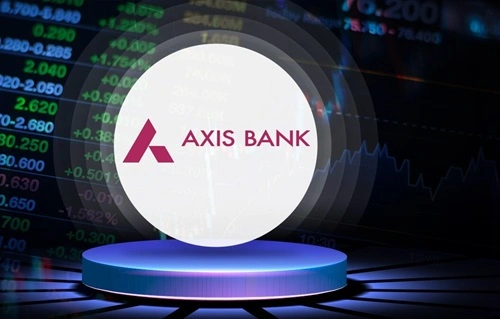Axis Bank (NSE: AXSB) is India’s fourth-largest private-sector bank. In Q1 FY26, standalone net profit declined 4% YoY to ₹5,806 cr, mainly due to a 190% sequential jump in provisions and NIM contracting 17 bps to 3.80%, despite a modest 1% increase in NII to ₹13,560 cr.

SWOT Analysis
Strengths
1. Robust financial engine: Net Interest Income grew (+1% YoY) and core operating profit rose 5% YoY, supported by rising fee income (up 10%) and trading income (+249%). Return on Equity, while down YoY, remains strong at ~13%, supported by a successful ₹2,000 cr share buyback and capital ratio of ~16.8% .
2. Extensive branch and digital network: Axis has 5,700+ branches, 14,500+ ATMs, and advanced hybrid cloud infrastructure, enabling uninterrupted services, including remote work. Investments in Axis Thought Factory and fintech partnerships enhance digital scalability.
3. Diversified business portfolio: Offers a full suite of banking products—retail, SME, corporate, international, wealth, insurance, and mutual funds—helping reduce dependency on a single segment. Strong fee income stream (constituting ~25% of non‑interest income) stabilizes revenue amid interest volatility.
Weaknesses
1. Asset quality deterioration: Q1 saw gross NPA rise to 1.57% (from ~1.28%) and slippages jump to ₹8,200 cr from ₹4,800 cr last quarter, as credit costs rose to 1.38%. Elevated provisions (₹3,948 cr) raised concerns over risk management.
2. Margin pressure: NIM decline (from ~4.05% to 3.80%) reflects competitive lending and rate cycle headwinds, compressing interest profitability.
3. Concentration in urban and retail markets: While rural and MSME penetration exists, Axis lacks deep reach in smaller towns compared to peers.
4. Employee attrition and inconsistent customer experience: Reports of workforce dissatisfaction and mixed customer reviews warrant attention.
Opportunities
1. Digital banking and payments leadership: UPI GMV surged 45% QoQ in Q1, with 14% user increase, offering a base for upselling banking products . Strategic fintech and Amazon/Visa partnerships present scalable growth in digital and merchant services .
2. Retail and gold-loan portfolio ramp-up: Relaunching gold loans positions Axis in high-yield secured lending, complementing its retail strategy.
3. SME and corporate expansion: Growing micro-business financing, home loans, and corporate growth in tier 2/3 towns expands asset base and risk diversification .
4. International and wholesale banking: Network in Singapore, Dubai, UK, and growing inward remittance hubs can be leveraged for cross-border corporate banking .
Threats
1. Rising credit and macroeconomic risk: Elevated probabilities of SME/retail slippages amidst economic stress and competitive lending may necessitate higher provisions.
2. Stretched competition and pricing pressure: HDFC, ICICI, and emerging fintech are offering competitive interests and services, pressuring NIM and wallet share.
3. Regulatory and compliance burden: Ongoing risk from NPAs, RBI norms, and capital adequacy require disciplined provisioning and robust risk management.
4. Global headwinds and external shocks: Currency volatility, commodity cycles, and rate reversals may impair borrower repayment ability and bank margins.
Future Outlook
In FY26, Axis Bank must balance competing priorities: rein in asset-quality deterioration, safeguard NIM, and sustain digital growth.
Key strategic priorities include:
- Tightened risk underwriting — Accelerate vintage analysis of slippages, reinforce early warning systems, and bolster coverage ratios to 140%+.
- Margin stabilization — With rate cuts ahead, shift toward retail and secured lending to offset yields under pressure.
- Deepen digital loans & payments — Use ScaleUP digital platforms, UPI growth, and neo-banking strategies to boost CASA, wallet share, and fee income.
- Expand secured lending verticals — Gold, affordable housing, rural SMEs to diversify yields and client profiles.
- Strengthen customer & employee experience — Invest in retention, service quality, and feedback mechanisms to improve brand loyalty.
- Capitalize on international expansion — Leverage capabilities in cross-border trade, NRI banking, and TPM partnerships globally.
If Axis Bank can skillfully manage asset quality stress, defend margins, and double down on digital-led growth, it has the potential to deliver 15–18% RoE and sustainable earnings in the coming years—even as it navigates a cyclical credit and funding environment.